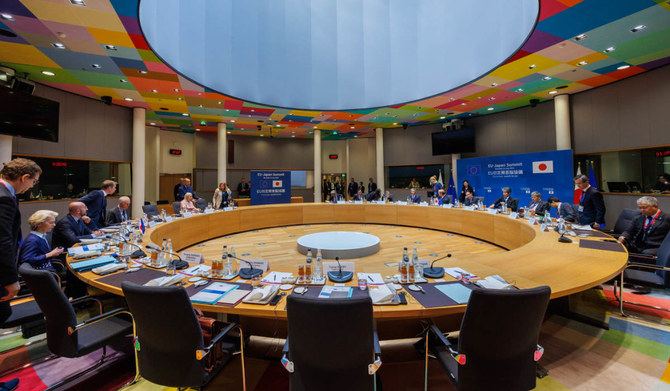Andrew Hammond
The EU and Japan have long been close, post-war allies. However, there are growing signs that their relationship is entering a “golden age” that could have significant geopolitical and economic ramifications well beyond their bilateral partnership.
Grand terminology such as “golden age” is, of course, highly subjective and can be prone to reversals. The UK and China, for instance, declared a “golden era” in their relationship when David Cameron became prime minister after the 2010 general election. However, this was soon jettisoned given the range of bilateral challenges that quickly arose.
Yet there do appear to be some strong reasons, including bilateral ties that seem to be at what might be an all-time high, why the “golden age” terminology is highly appropriate to EU-Japan relations, especially since the start of the war in Ukraine.
While the specific term has not yet been used extensively by politicians on either side, it has been voiced by a growing number of key thinkers, including leading diplomats such as Jean De Ruyt, the former Belgian permanent representative to the EU, NATO, and the UN.
One of the reasons for the growing use of the term is the wide range of important agreements between the two sides in recent years. These include the Japan-EU Economic Partnership Agreement; the EU-Japan Strategic Partnership Agreement; a bilateral Green Alliance; and a Partnership on Sustainable Connectivity and Quality Infrastructure.
Moreover, a joint declaration signed during the EU-Japan Summit in May 2022 underlined the growing common ground. This is underpinned not only by long-standing cooperation but also strong shared values and principles such as democracy, the rule of law, human rights, good governance, multilateralism, and open market economies.
What is particularly striking about the evolution of the bilateral relationship in recent years is the way in which what traditionally had been a partnership founded on economic cooperation has evolved into a deeper security relationship too. This has become particularly evident during the war in Ukraine but is not limited to the European theater.
Within Europe there has been a significant growth of interest in, and understanding of, the Asia Pacific region. This was showcased when the EU published its new strategy for cooperation with the region, which clearly demonstrated in a number of ways that Brussels views Japan as a key partner there, from fresh economic cooperation in key sectors such as railways to wider security activities such as joint naval exercises.
The growing depth and breadth of bilateral relations was clear during the important EU-Japan annual summit that took place on Thursday, during which the agenda included the next steps in the implementation of blossoming strategic, economic and connectivity partnerships.
Inevitably, Ukraine topped the agenda, especially in the context of the NATO summit in Vilnius on Tuesday and Wednesday of last week. Japan, which last year was invited to the military alliance’s annual leadership conference for the first time, has been steadfast in its support for Ukraine since Russia’s invasion, including the clear international leadership it showed when it chaired the G7 in 2023. It has sought to draw a parallel between the security threat Russia poses to Ukraine, and to Europe more widely, and the threat posed by China in the Asia Pacific.
The warming of the EU-Japan defense relationship therefore comes amid growing mutual concerns about the ambitions of Moscow and Beijing. Meanwhile, the Trump presidency showed that the US might not always be the very dependable ally it once was.
For example, France, the only nuclear power in the EU, and Japan are strengthening their security ties, and Paris intends to make the Asia Pacific a priority axis of its diplomacy. France, which is already active in Japan’s civil nuclear industry, also wants to strengthen its presence in the nation’s military sector, given Tokyo recently announced a significant increase in spending on its armed forces.
Beyond Ukraine, there is a rich agenda of ideas to help move the EU-Japan partnership into ever-more positive territory. This includes enhanced maritime security cooperation; greater infrastructure development; better alignment of the EU’s Global Gateway foreign agenda; and the Japan-EU Partnership on Sustainable Connectivity and Quality Infrastructure.
There is also significant scope to build on the bilateral Green Alliance and enhance the partnership in energy security, decarbonization, and green supply chains, including critical minerals. This is especially the case given mutual concerns about the implications of the US Inflation Reduction Act.
Taken together, what all these things reveal are the growing opportunities for the EU and Japan to make a much bigger global impact across a wide range of issues, against the backdrop of a fast-changing international geopolitical and economic landscape. A model for what could be achieved is illustrated by the leadership qualities both sides have shown on the international trade and rules-based economic order agenda in recent years.
This bilateral push shifted up several gears when, during Trump’s presidency, the US de-emphasized this agenda amid his administration’s focus on “America First.”
Around the same time, the EU-Japan trade agreement, which covers about a third of global gross domestic product and a combined population of almost 650 million people, showed the world a different path forward by promoting a commitment to multilateralism and trade liberalization.
This deal was not only important in and of itself, it also helped shape the wider diplomacy of trade negotiations at key forums such as the G20 summit hosted by Japan in 2019 and various G7 leadership meetings.
Therefore, the EU-Japan summit provided another illustration of why their bilateral ties are at a historic high. The two powers have become global leaders on issues such as the multilateral trade system, the rules-based economic order, and even liberal democracy itself. This could extend in coming years to wider agendas such as energy security and green growth.







